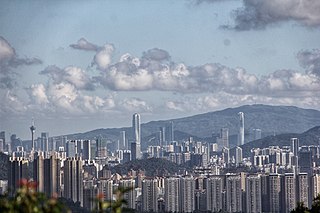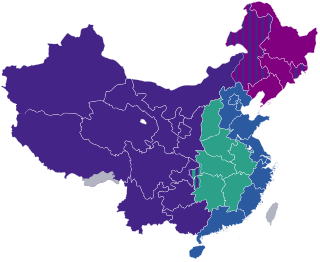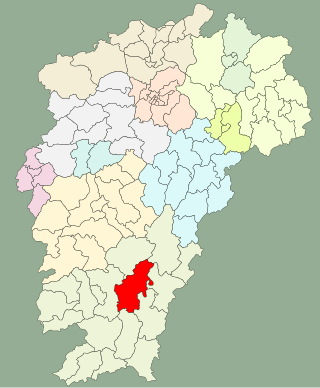
In urban planning, zoning is a method in which a municipality or other tier of government divides land into "zones", each of which has a set of regulations for new development that differs from other zones. Zones may be defined for a single use, they may combine several compatible activities by use, or in the case of form-based zoning, the differing regulations may govern the density, size and shape of allowed buildings whatever their use. The planning rules for each zone determine whether planning permission for a given development may be granted. Zoning may specify a variety of outright and conditional uses of land. It may indicate the size and dimensions of lots that land may be subdivided into, or the form and scale of buildings. These guidelines are set in order to guide urban growth and development.

Qinhuangdao is a port city on the coast of China in northern Hebei. It is administratively a prefecture-level city, about 300 km (190 mi) east of Beijing, on the Bohai Sea, the innermost gulf of the Yellow Sea. Its population during the 2020 national census was 3,136,879, with 1,881,047 people living in the built-up area made up of 4 urban districts.

Zhuhai is a prefecture-level city located on the west bank of the Pearl River estuary on the central coast of southern Guangdong province, People's Republic of China, on the southeastern edge of the Pearl River Delta. Its name literally means "pearl sea", which originates from the city's location at the mouth of the Pearl River meeting the South China Sea. Zhuhai borders Jiangmen to the west, Zhongshan to the north and Macau to the southeast, and shares maritime boundaries with Shenzhen and Hong Kong to the northeast across the estuary.

Langfang is a prefecture-level city of Hebei Province, and was known as Tianjin Prefecture until 1973. It was renamed Langfang Prefecture after Tianjin became a municipality and finally upgraded into a prefecture-level city in 1988. Langfang is located approximately midway between Beijing and Tianjin. At the 2020 census, the population of Langfang was 5,464,087, of whom 1,147,591 lived in the built-up area made of Guangyang and Anci districts; its total area is around 6,417.28 km2 (2,477.73 sq mi). Langfang borders Baoding to the southwest, Cangzhou to the south, Beijing to the north and Tianjin to the east. Sanhe City and Dachang Hui County are now conurbated with Beijing, so that they form part of the same built-up area. Langfang is the smallest prefecture-level city of Hebei Province by land area.

Kunshan is a county-level city in southeastern Jiangsu province with Shanghai bordering its eastern border and Suzhou on its western boundary. It is under the administration of the prefecture-level city of Suzhou.

Baoji is a prefecture-level city in western Shaanxi province, People's Republic of China. Since the early 1990s, Baoji has been the second largest city in Shaanxi.

The Rise of Central China Plan is a policy adopted by the People's Republic of China to accelerate the development of its central regions. It was announced by Premier Wen Jiabao on 5 March 2004 during his delivery of the Annual Work Report of the State Council. It covers six provinces: Shanxi, Henan, Anhui, Hubei, Hunan, and Jiangxi.

Midong District is one of 7 urban districts of the prefecture-level city of Ürümqi, the capital of Xinjiang Uygur Autonomous Region, Northwest China. Its land area is 3,408 km2 (1,316 sq mi); it has a population of 296,000.

Zhuozhou, is a county-level city with 628,000 inhabitants in central Hebei province, southwest of Beijing. It is administered by Baoding prefecture-level city. Zhuozhou has 3 subdistricts, 6 towns, 5 townships, and 1 development zone.

Dalingshan is a town under the jurisdiction of Dongguan prefecture-level city in the Pearl River Delta region of Guangdong province, China. Songshan Lake Hi-Tech Industrial Development Zone is situated in the hinterland of the Guangdong-Hong Kong-Macao Greater Bay Area (GBA).

Yudu County is a county under the administration of the prefecture-level city of Ganzhou, located in the south of Jiangxi province, China. It is located in the east of Ganzhou City. It is adjacent to Ruijin City to the east, Huichang County and Anyuan County to the south, Ganxian District to the west, and Xingguo County and Ningdu County to the north. With a total area of 2893 square kilometers, it has jurisdiction over 9 towns and 14 townships, with a total registered population of 1.115 million. The county government is stationed in Gongjiang Town.

Dingyuan County is a county of Anhui Province, China. It is under the administration of Chuzhou city.

Jiujiang District is a district of the city of Wuhu, Anhui Province, China.
Liangzihu District is a district of the city of Ezhou, Hubei, People's Republic of China.
Dalad Banner is a banner of western Inner Mongolia, China, lying on the southern (right) bank of the Yellow River. It is under the administration of Ordos City, although it is closer to the city of Baotou, 33 kilometres (21 mi) to the north-northwest.
The Wimmersperg Spz was a family of German assault rifles that was in the planning stage during the latter days of Nazi Germany.
The Ngari Capes Marine Park is a marine protected area on the lower south west coast of Western Australia, located approximately 250 kilometres (160 mi) south of Perth. The 123,790-hectare (305,900-acre) marine park was gazetted on 12 June 2012 and the park's western and southern boundaries are the limit of coastal waters of Western Australia, abutting the South-west Corner Marine Park located within the Australian Commonwealth exclusive economic zone.
PfSPZ Vaccine is a metabolically active non-replicating whole sporozoite (SPZ) malaria vaccine being developed by Sanaria against Plasmodium falciparum (Pf) malaria. Clinical trials have been safe, extremely well tolerated and highly efficacious. The first generation PfSPZ product is attenuated by gamma irradiation; the second generation vaccines PfSPZ-CVac and PfSPZ LARC2 are, respectively, attenuated chemically and genetically. Multiple studies are ongoing with trials of the PfSPZ vaccines. All three products are produced using the same manufacturing process. These products are stored and distributed below -150 °C using liquid nitrogen (LN2) vapor phase (LNVP) freezers and cryoshippers.
Sanaria is a biotechnology company developing vaccines protective against malaria and other infectious diseases as well as related products for use in malaria research. Sanaria's vaccines are based on the use of the sporozoite (SPZ) stage of the malaria parasite, Plasmodium, as an immunogen, and as a platform technology for liver-vectored gene delivery. SPZ are normally introduced into humans by mosquito bite where they migrate to the liver and further develop to liver stages, and eventually back into the blood stream where the parasite infects red blood cells (RBC) and causes malaria. Plasmodium falciparum is the species responsible for more than 95% deaths caused by malaria. The WHO estimates there were 249 million clinical cases and 608,000 deaths in 2022 alone.

Guangxi, officially the Guangxi Zhuang Autonomous Region, is an autonomous region of the People's Republic of China, located in South China and bordering Vietnam and the Gulf of Tonkin. Formerly a province, Guangxi became an autonomous region in 1958. Its current capital is Nanning.













